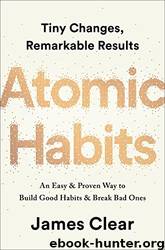Atomic Habits: Tiny Changes, Remarkable Results : An Easy & Proven Way to Build Good Habits & Break Bad Ones by James Clear

Author:James Clear
Language: eng
Format: epub
Tags: Business & Economics, Organizational Behavior, Psychology, Social Psychology, Self-Help, Personal Growth, General
Publisher: Penguin
Published: 2018-07-15T05:40:51+00:00
HOW TO AUTOMATE A HABIT AND NEVER THINK ABOUT IT AGAIN
John Henry Patterson was born in Dayton, Ohio, in 1844. He spent his childhood doing chores on the family farm and working shifts at his father’s sawmill. After attending college at Dartmouth, Patterson returned to Ohio and opened a small supply store for coal miners.
It seemed like a good opportunity. The store faced little competition and enjoyed a steady stream of customers, but still struggled to make money. That was when Patterson discovered his employees were stealing from him.
In the mid-1800s, employee theft was a common problem. Receipts were kept in an open drawer and could easily be altered or discarded. There were no video cameras to review behavior and no software to track transactions. Unless you were willing to hover over your employees every minute of the day, or to manage all transactions yourself, it was difficult to prevent theft.
As Patterson mulled over his predicament, he came across an advertisement for a new invention called Ritty’s Incorruptible Cashier. Designed by fellow Dayton resident James Ritty, it was the first cash register. The machine automatically locked the cash and receipts inside after each transaction. Patterson bought two for fifty dollars each.
Employee theft at his store vanished overnight. In the next six months, Patterson’s business went from losing money to making $5,000 in profit—the equivalent of more than $100,000 today.
Patterson was so impressed with the machine that he changed businesses. He bought the rights to Ritty’s invention and opened the National Cash Register Company. Ten years later, National Cash Register had over one thousand employees and was on its way to becoming one of the most successful businesses of its time.
The best way to break a bad habit is to make it impractical to do. Increase the friction until you don’t even have the option to act. The brilliance of the cash register was that it automated ethical behavior by making stealing practically impossible. Rather than trying to change the employees, it made the preferred behavior automatic.
Some actions—like installing a cash register—pay off again and again. These onetime choices require a little bit of effort up front but create increasing value over time. I’m fascinated by the idea that a single choice can deliver returns again and again, and I surveyed my readers on their favorite onetime actions that lead to better long-term habits. The table on the following page shares some of the most popular answers.
I’d wager that if the average person were to simply do half of the onetime actions on this list—even if they didn’t give another thought to their habits—most would find themselves living a better life a year from now. These onetime actions are a straightforward way to employ the 3rd Law of Behavior Change. They make it easier to sleep well, eat healthy, be productive, save money, and generally live better.
Download
This site does not store any files on its server. We only index and link to content provided by other sites. Please contact the content providers to delete copyright contents if any and email us, we'll remove relevant links or contents immediately.
Talking to Strangers by Malcolm Gladwell(11852)
The Compound Effect by Darren Hardy(7540)
The Lover by Duras Marguerite(7109)
Wonder by R. J. Palacio(7048)
Tools of Titans by Timothy Ferriss(6929)
The Circle by Dave Eggers(6246)
A Court of Wings and Ruin by Sarah J. Maas(6049)
Kaplan MCAT General Chemistry Review by Kaplan(6043)
Deep Work by Cal Newport(5446)
To All the Boys I've Loved Before by Jenny Han(5175)
Wiseguy by Nicholas Pileggi(4576)
1,001 ASVAB Practice Questions For Dummies by Powers Rod(4033)
The Body: A Guide for Occupants by Bill Bryson(3787)
Barron's AP Biology by Goldberg M.S. Deborah T(3624)
Cracking the GRE Premium Edition with 6 Practice Tests, 2015 (Graduate School Test Preparation) by Princeton Review(3590)
ACT Math For Dummies by Zegarelli Mark(3558)
Eat That Frog! by Brian Tracy(3502)
Kaplan MCAT Organic Chemistry Review: Created for MCAT 2015 (Kaplan Test Prep) by Kaplan(3418)
Pre-Suasion: A Revolutionary Way to Influence and Persuade by Robert Cialdini(3402)
